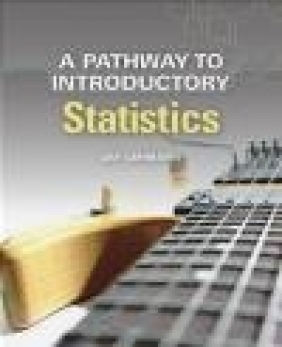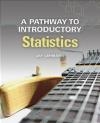A Pathway to Introductory Statistics
Jay Lehmann
A Pathway to Introductory Statistics
Jay Lehmann
- Producent: Pearson
- Rok produkcji: 2015
- ISBN: 9780134107172
- Ilość stron: 848
- Oprawa: Miękka
Niedostępna
Opis: A Pathway to Introductory Statistics - Jay Lehmann
For a one-semester alternative to the traditional two-semester developmental algebra sequence that prepares students specifically for an Introductory Statistics course. Looking for a new path in algebra? Using authentic data to make math meaningful to students, Jay Lehmann's A Pathway to Introductory Statistics provides a one-semester alternate path through developmental algebra to accelerate and prepare non-STEM students for introductory statistics. For many students' majors, the most fitting college-level math course is statistics. Tailoring their developmental sequence-in both content and approach-to prepare students for this course of study can only improve their success. Infused with highly relevant data sets throughout, Lehmann presents students with both an introduction to descriptive statistics and the requisite algebra topics needed for a statistics course, while demonstrating the close link between the two subjects. This text equips students to reason statistically as they discover the skills and concepts they'll need for statistics. Note: You are purchasing a standalone product; MyMathLab does not come packaged with this content. Students, if interested in purchasing this title with MyMathLab, ask your instructor for the correct package ISBN and Course ID. Instructors, contact your Pearson representative for more information. If you would like to purchase boththe physical text and MyMathLab, search for: 0134310039 / 9780134310039 Pathway to Introductory Statistics, A, Access Card Package Package consists of: 0134107179 / 9780134107172 Pathway to Introductory Statistics, A 0321431308 / 9780321431301 MyMathLab -- Glue-in Access Card 0321654064 / 9780321654069 MyMathLab Inside Star Sticker1. Performing Operations and Evaluating Expressions 1.1 Variables, Constants, Plotting Points, and Inequalities 1.2 Expressions 1.3 Operations with Fractions and Proportions; Converting Units 1.4 Absolute Value and Adding Real Numbers 1.5 Change in a Quantity and Subtracting Real Numbers 1.6 Ratios, Percents, and Multiplying and Dividing Real Numbers 1.7 Exponents, Square Roots, Order of Operations, and Scientific Notation Hands-On Projects: Stocks Project 2. Designing Observational Studies and Experiments 2.1 Simple Random Sampling 2.2 Systematic, Stratified, and Cluster Sampling 2.3 Observational Studies and Experiments Hands-On Projects: Survey about Proportions Project; Online Report Project 3. Graphical and Tabular Displays of Data 3.1 Frequency Tables, Relative Frequency Tables, and Bar Graphs 3.2 Pie Charts and Two-Way Tables 3.3 Dotplots, Stemplots, and Time-Series Plots 3.4 Histograms 3.5 Misleading Graphical Displays of Data Hands-On Projects: Student Loan Default Project 4. Summarizing Data Numerically 4.1 Measures of Center 4.2 Measures of Spread 4.3 Boxplots Hands-On Projects: Comparison Shopping of Cars Project 5. Computing Probabilities 5.1 Meaning of Probability 5.2 Complement and Addition Rules 5.3 Conditional Probability and the Multiplication Rule for Independent Events 5.4 Finding Probabilities for a Normal Distribution 5.5 Finding Values of Variables for Normal Distributions Hands-On Projects: Heights of Adults Project 6. Describing Associations of Two Variables Graphically 6.1 Scatterplots 6.2 Determining the Four Characteristics of an Association 6.3 Modeling Linear Associations Hands-On Projects: Climate Change Project; Volume Project Linear Graphing Project: Topic of Your Choice 421 7. Graphing Equations of Lines and Linear Models; Rate of Change 7.1 Graphing Equations of Lines and Linear Models 7.2 Rate of Change and Slope of a Line 7.3 Using Slope to Graph Equations of Lines and Linear Models 7.4 Functions Hands-On Projects: Climate Change Project; Workout Project; Balloon Project 8. Solving Linear Equations and Inequalities to Make Predictions 8.1 Simplifying Expressions 8.2 Solving Linear Equations in One Variable 8.3 Solving Linear Equations to Make Predictions 8.4 Solving Formulas 8.5 Solving Linear Inequalities to Make Predictions 9. Finding Equations of Linear Models 9.1 Using Two Points to Find an Equation of a Line 9.2 Using Two Points to Find an Equation of a Linear Model 9.3 Linear Regression Model Hands-On Projects: Climate Change Project; Golf Ball Project; Rope Project; Shadow Project; Linear Project: Topic of Your Choice 10. Using Exponential Models to Make Predictions 10.1 Integer Exponents 10.2 R ational Exponents 10.3 G raphing Exponential Models 10.4 Using Two Points to Find an Equation of an Exponential Model 10.5 E xponential Regression Model Hands-On Projects: Stringed Instrument Project; Cooling Water Project Exponential Project: Topic of Your Choice Appendices A. Using A TI-84 Graphing Calculator A-1 A.1 Turning a Graphing Calculator On or Off A.2 Making the Screen Lighter or Darker A.3 Selecting Numbers Randomly A.4 Entering Data for a Single Variable A.5 Constructing a Frequency Histogram A.6 Computing Median, Mean, Standard Deviation, and other Measures A.7 Constructing a Boxplot A.8 Computing Probabilities for a Normal Distribution A.9 Finding a Value of a Variable for a Normal Distribution A.10 Constructing a Time-Series Plot or Scatterplot A.11 Constructing Two Scatterplots That Share the Same Axes A.12 Computing Correlation Coefficients and Coefficients of Determination A.13 Turning a Plotter On or Off A.14 Entering an Equation A.15 Graphing an Equation A.16 Tracing a Curve without a Scatterplot A.17 Zooming A.18 Setting the Window Format A.19 Graphing Equations with a Scatterplot A.20 T racing a Curve with a Scatterplot A.21 Constructing a Table A.22 Constructing a Table for Two Equations A.23 Using "Ask" in a Table A.24 Finding the Intersection Point(s) of Two Curves A.25 Turning an Equation On or Off A.26 Finding a Regression Equation A.27 Constructing a Residual Plot A.28 Responding to Error Messages B. Using Statcrunch B.1 Selecting Numbers Randomly B.2 Entering Data B.3 Constructing Frequency and Relative Frequency Tables B.4 Constructing Bar Graphs or Multiple Bar Graphs B.5 Constructing Pie Charts B.6 Constructing Two-Way Tables B.7 Constructing Dotplots B.8 Constructing Stemplots and Split Stems B.9 Constructing Time-Series Plots B.10 Constructing Histograms B.11 Computing Medians, Means, Standard Deviations, and Other Measures B.12 Constructing Boxplots B.13 Computing Probabilities for a Normal Distribution B.14 Finding Values of a Variable for a Normal Distribution B.15 Constructing Scatterplots B.16 Computing Linear Correlation Coefficients and Coefficients of Determination B.17 Finding Linear Regression Equations B.18 Constructing Residual Plots for Linear Regression Models C. Standard Normal Distribution Table C-1
Producent:
GPSR Pearson Central Europe Sp. z o.o.
ul. Szamocka 8
01-748 Warszawa (PL)
tel: 459 596 060
email: [email protected]
Szczegóły: A Pathway to Introductory Statistics - Jay Lehmann
Tytuł: A Pathway to Introductory Statistics
Autor: Jay Lehmann
Producent: Pearson
ISBN: 9780134107172
Rok produkcji: 2015
Ilość stron: 848
Oprawa: Miękka
Waga: 1.55 kg






























